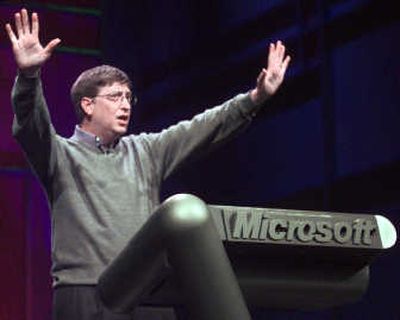Gates still rates seer position

For the 10th time, Bill Gates will inaugurate the International Consumer Electronics Show in Las Vegas by touting new Microsoft Corp. products and describing his view of the future of computing.
Before you rush to the edge of your seat Sunday, consider this: Gates is a mediocre prognosticator.
In fairness, as the old joke goes, predictions are very hard, especially ones about the future. Scouting a technology on the horizon is one thing; it’s another to foresee the business-execution problems and competitive troubles that might waylay it.
But hey, this is Bill Gates. That savvy guy who has spent more than 30 years atop what remains (for now, at least) the dominant entity in personal computing, a company that pours $7 billion a year into research and development. His drawing power is so strong that CES organizers always give Gates top billing at the industry’s premier extravaganza.
And so, since this is Gates’ last keynote before he leaves his day-to-day Microsoft duties to focus on philanthropy, it’s as good a time as any to scour his track record.
First, the highlights.
They include Gates’ debut of the Xbox video game console at CES in 2001. The Xbox became Microsoft’s most successful piece of hardware.
In 2000, Gates correctly explained the rising importance of networked mobile devices, even as PCs were still becoming more prevalent.
And if you were paying attention to Gates in 1999, you would have had early word about the importance of XML, a programming system that has made it easier for computers to share information.
As for his lesser moments …
“At CES in 1995, Gates described a way to make “the computing experience better.” Its name was Bob. Bob was a $100 Microsoft program that tried to make word processing, accounting and e-mail more intuitive. Featuring images of rooms in a house and cartoon characters, Bob let users click on say, a piece of paper on a desk to launch a letter-writing program. Some analysts gasped that Bob put Microsoft way ahead of Apple Inc. in a crucial race to incorporate cartoon characters in PC use. But Bob required twice as much memory as most home computers had back then, found few buyers, and became an infamous bomb.
“ In 2002, Gates told CES that “entertainment will never be the same.” Why not? Because of a wireless device code-named Mira. It was a portable, touch-screen monitor that could display Internet content and music files streamed from a home PC into more relaxed settings like the couch or the kitchen. But it didn’t work with the Home Edition of Windows XP; it required the pro version. And it couldn’t show video. Microsoft said in 2004 it was moving on.
“At Comdex in 2002, Gates said the next computing revolution would include SPOT – Microsoft’s “smart personal objects technology.” The idea was that pens, watches and other everyday things could tap into the Internet and show real-time tidbits of information, like news headlines, weather updates or sports scores. Well, first Microsoft and partner companies had to design a new operating system and low-power chips for objects, plus a wireless transmission network for SPOT data. The initial output – some watches, a weather gizmo and a coffee maker – was far from revolutionary. Only now is SPOT beginning to show real value, in navigation devices.